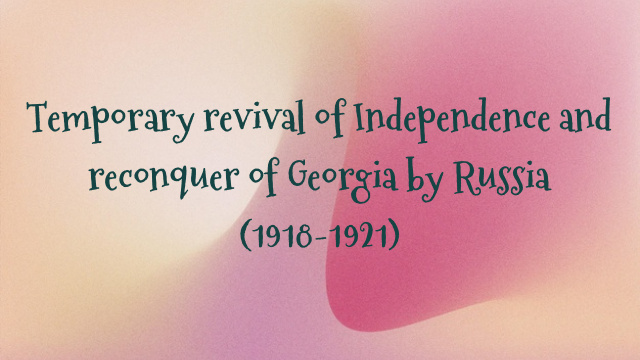
Temporary revival of Independence and reconquer of Georgia by Russia (1918-1921)
After February, 1917 revolution democratic changes took place in Russia. One of the results of those changes in Georgia was revival of independence of the orthodox church (March, 1917). But the temporary government of Russia couldn’t decide those cardinal issues, which especially bothered the wide layers of population: pax issues (country kept participating in the World War), land issues etc. This condition was well used by Bolsheviks (Communists) with the leadership of Lenin and in October, 1917 they overthrew the temporary government. Transcaucasian political parties and organizations didn’t acknowledge the legacy of these changes. On November 15, 1917 they created their own government – Transcaucasian Commissariat, which consisted mainly of local parties. In fact, the process of separation of Transcaucasia from Russia, began.
This process juridically ended on April 9 (22), 1918, when the creation of independent Transcaucasia federation was declared, with the center in Tbilisi. The supreme state body of new-created republic was represented by many-partied Same , the chairman of which was elected Georgian social-democrat, N. Chkheidze. The deputy-chairmen were the representatives of Armenia and Azerbaijan.
One of the most important problems, which stood in front of Transcaucasian government, was the questions of arrangement the situation with Turkey, because the War was lasting, the Russian army, which fought against Turkey, was decomposed, soldiers left their positions and returned at home, and new-established Georgian-Armenian groups couldn’t stop the Turkish army. Azerbaijan refused to struggle against Turkey, which was of the same religion and ethnically related.
During the Pax negotiations with Turkey, there appeared the truth, how unreliable was the unifying of Transcaucasia. Between the Georgian, Armenian and Azerbaijanian deputations of Same, there existed the permanent discord. Azerbaijanian politicians were on the side of Turkey, which declared its territorial requirements to Transcaucasia . Georgia and Armenia were oriented towards Germany, to have the influence on its ally. And, with the help of interfering from Germany, Georgia avoided Turkish occupati on. Turks occupied only South-West part with Batumi.
Life showed that Transcaucasia Republic was not a perspective creature. It didn’t exist longer than two months and was destroyed after the inner resistances. On May 26, 1918 on the last meeting, Same officially declared the abolishment of Federation. In the evening of the same day, the sitting of “the national council” of Georgia was held, on which Georgia was declared as the Sovereign-democratic Republic. During the next two days Armenia and Azerbaijan declared their independence too.
Thus, on May 26, 1918 Georgian State, abolished 117 years ago, was revived. Georgian people accepted this fact with celebration. This historical event was the crown result of the national and social-liberating actions of XIX-XXs Georgia. This day, May 26 is celebrated as the national independence day in today’s Georgia as well.
The first government of the Republic of Georgia was coalitional, though it consisted mainly of social-democrats. Social-democratic party was the strongest in Georgia. The leader of the party, Noe Zhordania (1868-1953) became the chairman of the government of Georgia.
The young republic stood in front of the hard economical problems. The World War caused the important damage to the economy, and the situation was hardened by the ceasing of economical relations with Russia and other countries. Industry and transportat ions were out of actions, there was a lack of food. And the government had no any capital in the stable currency, while declaring the independence.
Germany recognized the independence of Georgia on May 28. But after the defeat of the central states in the World War I, the question of international recognition became actual again. Government of Georgia appealed with this question to the Paris Peaceful Conference. In 1920, after Turkey, Germany and Argentina, Georgia was recognized as de-facto by the Great Britain, France, Italy and Japan. And after May 7, 1920, when Soviet Russia confessed the Independence of Georgia, the republic was recognized as de-jure by Antanta countries and other states.
The establishment of Georgian democratic republic was running in the most difficult political condition. At first, the country was not recognized by Russian “White Action”, which had a motto of “Entire and Indivisible” Russia. Issues, concerning border s between Transcaucasian Republics were not arranged as well. In particular, Georgia had a territorial quarrel with Azerbaijan about Zakatala district. And Armenian Republic had a claim on South regions of Georgia, where the large part of population was of Armenian origin . In December, 1918 Armenian armies imprudently invaded Georgia but they were defeated. Military actions in Transcaucasia were ceased by the interference of English captainship.
In the South part of the disputable region, there was created so-called “Neutral Zone”, with Georgian-Armenian administration. The entire jurisdiction of Georgia revived in this region only in November, 1920. In 1918-1920 there were local military move ments in South-West Georgia as well, in Abkhazia, on the territories inhabited by Southerner Osetians and in other regions, where armed actions took place. The important part of those actions were caused by the agitation of Communists.
In spite of these facts, the first hardest steps in creation the State, were overcome. At the end of 1920, the marks of economical and political stabilization in the republic were noticeable. Georgia got back Batumi region, which was occupied by English after the defeat of Turkey in the World War. Science and culture began to revive. The high-educational organizations – the University and the Conservatoire, appeared in Tbilisi. And if not the new intervention and annexation, Georgia could get rid of the crisis and stand on the way to the independent development. But the things turned on the contrary. In 1920, the main counterrevolutionary forces in Russia were exterminated, and the process of re-annexation of every domain of the Empire, began. In the same year, Azerbaijan and Armenia were forced to accept the Soviet regime. So, by the beginning of 1921, Georgia with 78 per cents of perimeter of its land borders, was in the Soviet siege. From South-West part, the neighbor was the young Turkish Republic.
As it was mentioned above, between Georgia and Soviet Russia, there existed May 7, 1920 Agreement, according to which, Russia acknowledged the State independence of Georgia. In return, Georgia pledged the free local activity for Communists on its territory. But soon it became clear, that Russia needed this Agreement only to weaken Georgian sobriety and to create working conditions for its agents in Georgia. Moscow was preparing for military intervention and making the last independent Transcaucasian republics Soviet. It should be denoted , that the negative role for Georgia in this action, was played by the high-rank Georgian communists – I. Stalin, S. Orjonikidze etc.
On February 12, 1921, in the region, contiguous to Armenia, communists arranged the peasant rebellion imitation, and on February 16, on the ground of the aid to the “rebels”, Russian armies invaded Georgia. The main grouping of the rival side – the Eleventh Army, advanced Tbilisi from the territories of Armenia and Azerbaijan. Besides, the separate formations and subdivisions advanced Abkhazia and central Caucasia passes. After the bitter struggles near Tbilisi on February 25, 1921, the capital of Georgia fell. Georgian armies receded. Social-democratic government couldn’t manage to organize the real public-general resistance. The situation aggravated on Turkey borders as well. On February 21, the government of Ankara required from Georgia to discharge t he cities: Artvin and Ardahan. This requirement was accomplished, but Turks didn’t stop and soon came to Batumi and Akhaltsikhe. On March 18, government of Georgia migrated abroad, and the Georgian military groups, left in Batumi, struggled with Turks and maintained the city. After Turks receded, Batumi was occupied by Russia. By March 19 in all the main centers of Georgia there was established the Soviet government. And before that, on March 16, in Moscow, between Russia and Turkey there was made the agreement, accor ding to which Artvin, Ardahan and some other territories were passed to Turkey.
Thus, Soviet Russia, from one side, violated the May 7, 1920 Agreement and implemented the actual annexation of Georgia. There was established the Communistic dictatorship in the country.
by Dr. George Anchabadze




